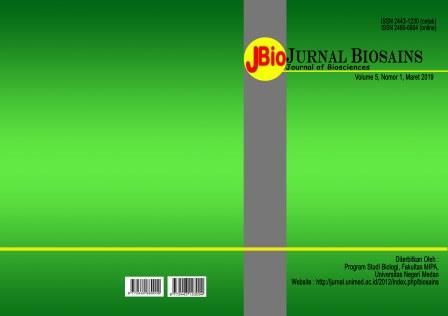IN VITRO ANTIFUNGAL EFFECTIVENESS OF AVOCADO PEEL EXTRACT (Persea Americana) AGAINST Candida albicans AND Aspergillus niger
DOI:
https://doi.org/10.24114/jbio.v5i1.12378Keywords:
Avocado Skin, Antifungal EffectivenessAbstract
Abstrak Banyak sekali jenis tanaman di Indonesia yang diduga memiliki potensi sebagai antifungi, tetapi belum dimanfaatkan secara optimal. Buah alpukat (Persea americana) adalah salah satu jenis tanaman yang dapat digunakan sebagai antijamur. Penelitian ini bertujuan untuk mengetahui efektivitas ekstrak antijamur kulit alpukat (Persea americana) terhadap pertumbuhan jamur Candida albicans dan Aspergillus niger.Ekstraksi dilakukan dengan maserasi menggunakan etanol 96%. Jamur uji yang digunakan adalah Candida albicans dan Aspergillus niger dengan konsentrasi 25%, 50%, 75%, dan 100% dengan pengulangan kerja 3 kali. Metode yang digunakan dalam penelitian ini adalah metode difusi cakram dengan pelarut DMSO.Hasil penelitian menunjukkan bahwa ekstrak kulit buah alpukat memiliki efektivitas antijamur pada jamur Candida albicans dan Aspergillus niger yang ditunjukkan oleh hasil zona hambat terbesar pada konsentrasi 100% dan zona hambat terkecil di 25%. Analisis data menggunakan uji hubungan antara perbedaan nilai rata-rata dilakukan oleh uji One Way ANOVA pada tingkat kepercayaan 95% (α = 0,05). Hubungan ini disebut bermakna jika p <0,05.References
Adams, George L. 1997. Boeis : Buku Ajar Penyakit THT (Translation and Adaption of Boeis). Jakarta : EGC
Anggraini, V., Masfufatun, M.2017. EFEKTIVITAS KOMBINASI EKSTRAK DAUN SIRIH MERAH (Piper Crocatum) DAN EKSTRAK BIJI ALPUKAT (Persea americana) DALAM MENGHAMBAT PERTUMBUHAN Candida albicans. Jurnal Kimia Riset 2(2), 86-92.
Dewi, S. R. dan Sulistyowati. 2013. Penggunaan Ekstrak Biji Buah Alpukat (Persea americana Mill.) Sebagai Antibakteri Proteus mirabilis dan Aerobacter aerogenes. Jurnal Kimia Riset 6(2), 31-34.
Dorland, W. (2012). Kamus Kedokteran Dorland. Jakarta: Buku Kedokteran EGC.
Dumasari, Ramona Lubis. (2008). Aspergillus. Departemen Ilmu Kesehatan Kulit dan Kelamin Fakultas kedokteran Universitas Sumatera Utara.
Freisleben SH, Anna KJ. 2014. Correlation between Plant Secondary Metabolites and Their Antifungal Mechanisms“A Review. Med Aromat Plants. 3(2), 1-6.
Hare, R., 1993, Mikrobiologi dan Imunologi, 1-2, 197, diterjemahkan oleh Praseno, Penerbit Yayasan Essentia Medica, Yogyakarta.
Harliana, Dilla., 2006, Aktivitas Antijamur Ekstrak Rimpang Temu Glenyeh. Fakultas MIPA UNS, Surakarta, 16.
Karlina, Y, et al., (2016). PENGUJIAN POTENSI ANTIJAMUR EKSTRAK AIR KAYU SECANG TERHADAP Aspergillus niger DAN Candida albicans. Chimico et Natura Acto 4(2), 84-87.
Kaur et al., (2000). Otomycosis: A Clinicomycologic Study. ENT-Ear, Nose & Throat Journal. 79(8), 606-9.
Kurniawan, Y. (2010). Otomikosis, Jamur yang Tumbuh di Telinga. Diakses 28 Januari
Marlinda, L., Aprilia, E. (2016). Otomikosis Auris Dekstra Pada Perenang. J Medula Unila 6(1), 67-71.
DN, Ahsani. (2014). Respon Imun Pada Infeksi Jamur. Jurnal Kedokteran dan Kesehatan Indonesia 6(2), 55-66.
Pelczar, M. .. and E. C. S. Chan. 2009. Dasar-Dasar Mikrobiologi 2. Jakarta: UI Press.
Pradhan B, Tuladhar NR, Amatya RM. 2003. Prevalence of Otomycosis In Outpatient Department of Otolaryngology in Tribhuvan University Teaching Hospital, Kathmandu, Nepal. Annals Of Otology, Rhinology & Laryngology. 112(4). 384-387.
Qomariyah et al., (2014). UJI EFEKTIVITAS ANTIJAMUR KRIM EKSTRAK KULIT DAN BIJI BUAH ALPUKAT (Persea americana Mill) TERHADAP Candida albicans. 1-15.
Rusmarjono, K., Soepardi, E., Iskandar, N. (2001). Buku Ajar Ilmu Kesehatan Telinga-Hidung-Tenggorok Kepala Leher. Jakarta : FK UI. 2001. h. 9-15
Sari, N. 2018. ISOLASI FUNGI ENDOFIT DAUN TALAS (Xanthosoma sagittifolium [L] Schott.) SEBAGAI PENGHASIL SENYAWA ANTIFUNGI. Fakultas Farmasi Universitas Hasanuddin Makassar.
World Health Organization (WHO). 2017. œTop 10 Causes of Death.
http://www.who.int/mediacentre/factsheets/fs310/en/
Published
Issue
Section
License
Copyright (c) 2019 Ester Putri Mentary Mendrofa

This work is licensed under a Creative Commons Attribution 4.0 International License.
For Authors Jurnal Biosains agree to the following terms:
Authors retain copyright and grant the Jurnal Biosains (JBIO) right of first publication with the work simultaneously licensed under a Creative Commons Attribution License (CC BY-SA 4.0) that allows others to share (copy and redistribute the material in any medium or format) and adapt (remix, transform, and build upon the material) the work for any purpose, even commercially with an acknowledgement of the work's authorship and initial publication in JBIO (Jurnal Biosains)
Authors are able to enter into separate, additional contractual arrangements for the non-exclusive distribution of the journal's published version of the work (e.g., post it to an institutional repository or publish it in a book), with an acknowledgement of its initial publication in JBIO (Jurnal Biosains)
Authors are permitted and encouraged to post their work online (e.g., in institutional repositories or on their website) prior to and during the submission process, as it can lead to productive exchanges, as well as earlier and greater citation of published work (See The Effect of Open Access).


